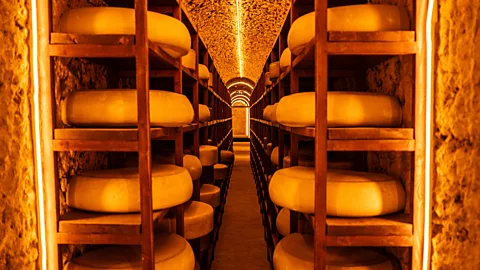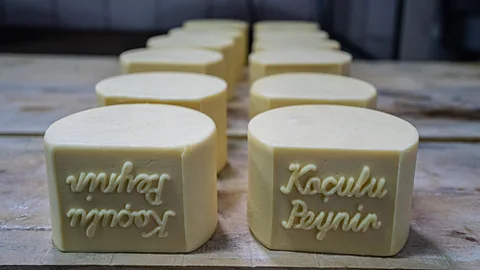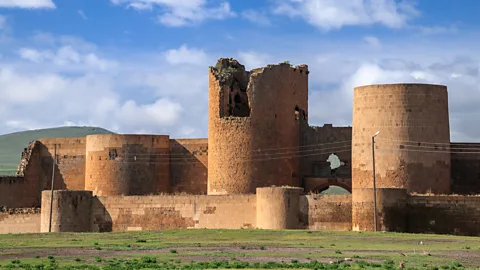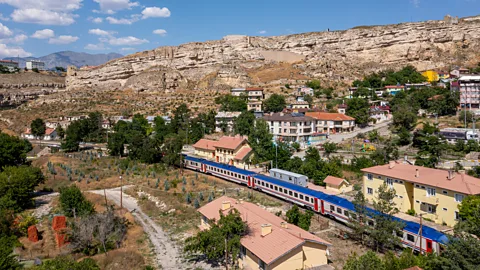 Richard Collett
Richard CollettLocated near the Armenian and Georgian borders, Turkey’s cheese capital is home to culinary traditions inherited from an exiled Russian sect.
Take the Doğu Ekspresi (The Eastern Express) from Ankara, cross the Euphrates River and 1,300km (808 miles) later, Turkey’s eastbound train line terminates in the little-visited frontier city of Kars.
Kars is just an hour’s drive from Georgia and Armenia, and in centuries past, the city has been fought over by countless empires and kingdoms. A towering 12th-Century castle dominates a skyline punctuated by minarets, Orthodox church domes and Russian blockhouses alike. The legacies of Romans, Byzantines, Armenians, Seljuk Turks, Ottomans and Czarist Russia all merge under mist-shrouded mountains. But here, the remnants of past empires have not only survived in the architecture but curiously, in the local cheese.
Home to cheesemaking traditions inherited from Russian exiles, distant Kars is Turkey’s cheese capital. Now, a new museum celebrates this cheesy heritage as local cheesemakers strive to introduce eastern Turkey’s culinary gifts to the wider world
“Kars cheese is famous in Turkey,” said Şeyma Çay, who creates itineraries for eastern Turkey travel specialists Silk Road Moments. “Kars’ Kashar is one of the most delicious cheeses in the country. The local cheeses are so famous because of the hundreds of different plant varieties in the region that are eaten by animals. The especially fatty milk they produce makes for extra flavourful cheeses.”
Indeed, Kars’ main street was lined with mandira (cheese shops) where tour groups (almost exclusively Turkish) were busy tasting and buying the local specialties, which include the Kars Kashar – an aged cheese made with cow and sheep’s milk – and my personal favourite, Kars Gravyer, a local hard cheese named after Swiss Gruyere that’s actually more akin in flavour to Emmental.
 Getty Images
Getty ImagesI lost count of the number of cheese mongers I passed on the way to Kars Peyniri Muzesi (Kars Cheese Museum), where replica wheels of Kars Gravyer framed an entranceway leading into a cold concrete fortress built in 1734 to defend Ottoman Kars against the expanding Russian Empire. “When the Russians annexed Kars in 1878, they used this stronghold to store cheese,” said museum “storyteller” and guide, Birol Aydin.
“Eight thousand years ago, people were making cheese on the Euphrates,” he added, noting that Turkey’s cheesemaking traditions date back to antiquity. “When the Turkish people were nomads in Central Asia, they were making cheese, and we have written references to Anatolian cheese as far back as the 12th Century CE.”
WORLD’S TABLE
BBC.com’s World’s Table “smashes the kitchen ceiling” by changing the way the world thinks about food, through the past, present and future.
When the Russians, who occupied much of what’s now Eastern Turkey from 1878 until 1918, exiled a religious spiritualist group named the Molokans to the region, they inadvertently gifted Kars with the modern cheesemaking traditions found here today. Molokan means “milk drinkers” and adherents to the sect were reviled in Russia for consuming dairy products during fasts like Lent when Orthodox Christians abstained.
Kars sits at an altitude of 1,756m (5,761ft), and Molokan dairy farms thrived in a cold, unforgiving climate where animal husbandry was the only way to survive the long winters. Aydin explained how the Molokans brought new types of cheese to eastern Turkey, and in the late 19th Century, Russians built the first modern cheese factory in Kars.
 Richard Collett
Richard CollettIn 1878, a visiting Swiss cheesemaker named David Moser found ripe conditions for Swiss cheese production, and he introduced the techniques and recipes still used to produce Kars Gravyer, now one of the most famous cheeses in Turkey. Professor Fügen Durlu-Özkaya, from the faculty of tourism, gastronomy and culinary arts at Ankara Hacı Bayram Veli University, later explained how Kars Gravyer’s appeal stems largely from its unique, local production methods that have remained faithful to their mixed 19th-Century Molokan-Swiss roots.
“Local cheesemakers use original production methods. Staying true to its essence affects its taste, which helps with its popularity,” she said. “The use of copper cauldrons in production, the use of original wooden shovels and the meticulous use of traditional methods in the ageing and ripening stages of the cheese are the elements that make it so special and delicious.”
The next day I had the chance to see these authentic production methods in action when I visited the cheesemaking village of Boğatepe, a half-hour drive through snow-draped landscapes from the city. Boğatepe is one of the original Molokan villages founded in the 19th Century, and while most Molokans returned to Russia after World War One or integrated into modern Turkey (I’m told there’s only one old man left in the village who calls himself a Molokan), their recipes have been preserved by successive generations of Turkish cheesemakers.
Boğatepe has a reputation for making some of the best cheese in Turkey, and almost all the cheese sold in the mandira down in Kars is produced in small, family-run factories here. The Koçulus are one of Boğatepe’s cheesemaking families, and I joined Çağdaş Koçulu – who styles himself as “The Master of Cheese” and has studied cheese production in Kars, Switzerland and Germany – for a grand tour of their factory. Milk was being boiled in Molokan copper pots that Koçuluclaimed are 150 years old, while wheels of Kars Gravyer ripened in cold cellars below the factory floor.
 Richard Collett
Richard CollettKars Gravyer requires a particular quality of cow’s milk that’s determined by what grasses and plants the cows have eaten, and as such, Kars Gravyer is only produced in spring and summer. I was visiting in January when less milk is available, so production was focused on a type of cheese they described as “fresh yellow cheese”, which is an un-aged version of Kars Kashar.
“The difference in the seasons affects the texture and taste of the cheese,” Koçulu explained, as he whipped out a penknife and sliced me off a few tasters of fresh, unripened Kashar they’d started preparing earlier that day. “Fresh yellow cheese is sweeter, more sugary than Kars Gravyer, which is saltier and sourer.”
Ripening time is just as important as the quality of milk, and Kars Gravyer is aged for a minimum period of six months and a maximum of four years. Fresh yellow cheese has a much shorter maturation time and can be ready in a few weeks or months, but when it’s ripened in hessian sacks, it can then be sold as “Aged Kars Kashar” (or “Old Yellow Cheese”, as Koçulu described it).
Boğatepe cheesemakers produce as many as 32 distinct cheese types, and they’re constantly developing or “discovering” new ones. “You cannot find this one in the supermarkets in Istanbul,” Koçulu said, showing me what he called “Caucasian Shepherd’s Cheese”. “This was a lost, forgotten cheese, but we rediscovered the recipe and started producing it again. No one else is making this type of cheese.”
He took me around Boğatepe’s small cheese museum, which tells the same story but is more rustic than the modern one in Kars, before we sat down in the dining room above his family’s cheese shop for the “Cheesemaker’s Breakfast” that they offer to visitors.
 Getty Images
Getty ImagesAs she laid out five or six cheeses on the wooden table, Koçulu’s mother, Nigar, explained how tourists make the short journey from Kars just for breakfast. They typically stop by on their way to other popular nearby sights in the region, like Lake Cildir, a vast freshwater lake that’s frozen in winter, and Ani, where you can visit the 11th-Century ruins of an Armenian kingdom’s former capital. As she poured endless cups of hot tea, Nigar also explained how cheesemaking saved Boğatepe.
“In 2000, there was a very sad traffic accident. Seventeen people from the village were killed,” she said, stopping me in my tracks, mid-bite. “Many of the villagers intended to migrate to the cities, to escape the memories.”
At the time of the disaster, Boğatepe’s cheese industry was stagnating, providing further reason to leave. Nigar’s brother, Ilhan Koçulu, rose to the challenge and convinced many would-be emigrants to stay as he secured funding from the United Nations Development Programme (UNDP). He launched a marketing campaign that reintroduced local cheeses like Kars Gravyer to cheese lovers across Turkey, which encouraged a surge in culinary tourists to Kars.
Assisted by UNDP funding, Ilhan, Nigar and another Boğatepe local, Zümran Ömür, also founded a women‘s co-operative, which provides a point of contact for visitors, trains local women in the nuances of the tourism industry and allows them to distribute bookings across homestays in the village. This means the cheesemakers can focus on their craft, keeping the mandira in Kars stocked with Kashar and Gravyer, as the cooperative deals with the tourism business in Boğatepe.
“The cooperative is for our kids,” Nigar said, outlining her hope that Boğatepe’s cheese-making traditions will survive well into the future. “It can help us to stay here and prevent the next generation from leaving for the bigger cities. Just look at my son. He stayed here and studied cheesemaking and now he’s become a successful businessman in the village.”
 Getty Images
Getty ImagesGiven the increasing popularity of the Eastern Express – which terminates in Kars and can sell out in seconds in the winter season – the city’s profile is certain to grow further in the future, opening new markets and inspiring more tourists to visit cheesemaking families like the Koçulus.
By the time I head back to Kars later that day I feel as if I’ve eaten a kilo of cheese, but that same evening, I’m consuming yet more of it as I watch Caucasus-style dancing in a restaurant named Pushkin. I willingly order yet another platter of local delicacies, including more Kars Gravyer, Tulum (a soft goat’s cheese, ripened in goatskin) and fresh, mellow Kashar. As Turkey’s east opens up to tourism, now’s the time for cheese lovers to make the pilgrimage to Kars, the country’s cheesy capital.

